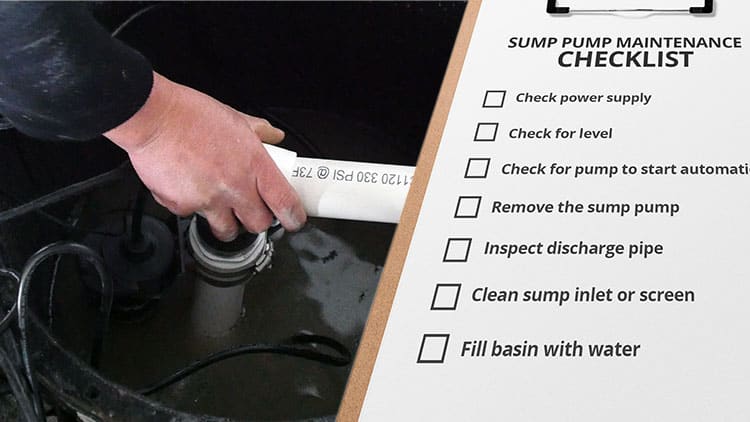How to Perform Sump Pump Maintenance for Reliability

Share this Post
Sump pump maintenance prevents flooding and protects your home from expensive repairs due to water damage. Therefore, experts and manufacturers recommend following an annual sump pump maintenance checklist. In just a few steps, you can maintain the functional reliability of your sump pump.
Before discussing how to keep sump pumps healthy, we need to explain how sump pumps work. Sump pumps are located at the lowest level of your house, typically the basement. You will find a sump pump in a basin below the basement floor.
You will have to remove a basin lid to access the pump. When groundwater rises inside the basin, the float attached to the pump switches on, activating the pump and draining the water from the basement to prevent flooding.
Table of Contents
Step-By-Step Annual Sump Pump Maintenance
Performing periodic sump pump maintenance throughout the year will ensure that the pump will protect your house from water damage. You risk costly and destructive flooding if you do not service your sump. Luckily, it only takes a few steps to do the periodic maintenance.
1. Check the Power Supply
Make sure the sump pump is on an independent circuit. Attach a surge protector with a built-in fault circuit protector, or plug directly into a GFCI socket to ensure your safety and protect against damage. A surge protector or GFCI socket protects against accidental shock or damage to your sump. They will both immediately cut power if there is a break in the grounding of the electrical current. Also, check the power cord. If you notice any damage, contact your sump pump installer immediately.
2. Check for Level Pump
When sump pumps run, the motor vibrates. Vibration movement and water in the sump basin can make the sump shift out of place. This shifting rarely happens but can occur on older systems. Visually inspect the pump and then use a level to ensure the pump is level both horizontally and vertically.
3. Check to Ensure the Pump Starts Automatically
Fill the sump basin with water. The float or pressure sensor will lift with the rising water, and the sump should immediately activate. While the sump is running, take notice of any sounds or smells that are out of the ordinary. If you notice anything strange, or the sump does not begin automatically, it may need to be repaired or replaced.
4. Remove the Sump Pump (Optional)
After verifying that the sump is functioning correctly, you should remove it from the basin and inspect the bottom. Often debris collects on the bottom. If you notice any debris, clean the bottom thoroughly, as debris can cause the sump to malfunction.
5. Inspect the Discharge Line
A Discharge line (pipe) removes groundwater from your house and transfers it to a dry well or municipal storm drain. Inspect every joint and look for any moisture which may indicate a leak.
The exterior drainage line leading to the dry well should extend well beyond your foundation to not add water to the water table near your home. Finally, inspect the discharge pipe’s vent to ensure no debris has settled in the vent, which can stop the water from draining out of the system properly.
6. Clean the Sump Inlet or Screen (Optional)
Before beginning, disconnect the power supply to the pump. If the sump is wired directly into the breaker box, flip the breaker into the off position before continuing. Remove the screen on the pump and clean it using a toothbrush and clean water. If the sump does not have a screen and only has an inlet opening, use clean water and a toothbrush to scrub away all debris.
7. Fill the Basin with Water (for Optional Steps 4 & 6)
It is possible for the water housed inside the sump basin to drain out slowly after you remove the sump pump. To avoid damaging the motor, pour water back into the sump basin and allow the unit to run until it turns off automatically.
Conclusion
Routine sump pump maintenance ensures your pump protects your house from water damage. A homeowner can efficiently perform all maintenance; however, you should contact your sump pump installers if an issue arises during your routine maintenance.
Sump pump installers understand the intricacies involved with the installation and repairs of sump pumps. If your sump is not turning on automatically, makes a strange noise, has a peculiar sound, or does not remove the water from the sump basin, contact your local sump pump installer for assistance.
Sump pump maintenance ensures that your sump pump will protect you for many years against flooding. Refer to this simple maintenance checklist every time you inspect your sump.
Do you need a new sump pump system or replace an old one?
Schedule a free, no-obligation inspection and quote at no cost.